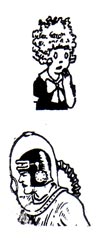|

This story was published in Radio Recall, the journal of the Metropolitan Washington Old-Time Radio Club, published six times per year.
Click here to return to the index of selected articles.
|
|
COMIC STRIPS & COMIC BOOKS OF RADIO’S GOLDEN AGE
 Ron Lackmann (Bear Manor Media) Ron Lackmann (Bear Manor Media)
Reviewed by Edgar Farr Russell, III © 2006
(From Radio Recall, August 2006)
In today’s era of blockbuster movies based on famous heroes like Superman, Batman, or the Fantastic Four, many younger fans might be surprised to learn this isn’t the first time the magical world of four-color comics has been embraced by the moguls of the entertainment industry. Since the dawn of the Twentieth Century, the printed exploits of both heroic and comic characters have been brought to life for millions of admirers by those in the theatre, movies, radio, and television. Likewise, through the decades a number of books have examined the history of one or more of these creations.
Now comes a long-overdue book which offers a comprehensive look at the many comics characters who made the transition to radio: Comic Strips & Comic Books of Radio’s Golden Age written by Ron Lackmann provides a great deal of information on 49 radio shows. The book which sells for $19.95 features an attractive color soft-cover and offers many black-and-white illustrations and photos among its 212 pages. It is available from Bear Manor Media; PO Box 750; Boalsburg, PA 16827 or at www.bearmanormedia.com.
Various shows, listed alphabetically, include such favorites as: Archie Andrews, Flash Gordon, Gasoline Alley, Little Orphan Annie, Superman, and Terry and the Pirates. For each entry Mr. Lackmann offers first a brief look at the life of the writer and/or artist of each title and the genesis of the character. He then describes chronologically the various appearances of the characters in different media with emphasis on radio. Finally, he introduces the major performers for each radio series and provides their biographies.
A work of this scope must encompass much research gathered from many sources. Because of this, the potential for incorporating incorrect information must remain always a vital concern. In my estimation the book is, unfortunately, significantly flawed.
The first area of concern is probably the least troubling. Although the book is described on the cover as “A Biography of All Radio Shows Based on Comics”, in fact many of these characters existed first as pulp magazine stories: Tarzan and Buck Rogers in the 25th Century; as movie stars: Roy Rogers and Tom Mix; or even as radio shows: Charlie McCarthy and The Green Hornet. To be sure the author does acknowledge this, but the fact remains the shows are not all based on comics.
What is more problematic is that much incorrect information has made its way into the book. One major example occurs in the Superman entry. Mr. Lackmann states that Superman’s creators Jerry Siegel and Joe Shuster remained “in firm control of all of the Superman spinoff comics such as Superboy, as well as the subsequent Superman films, TV shows, and a daily and Sunday Funnies comic strip feature.” Knowledgeable Superman historians know that the two never authorized National Comics to publish Superboy. Siegel and Shuster also sued to obtain a percentage of the profits from the publishing and merchandising of Superman.
During their lawsuit, which was settled in 1948, they were fired by the publisher and had their names removed from the comic book and comic strip. With the exception of a one-time payment for giving up the rights to Superboy, the two men had no involvement financially or otherwise with any aspect of Superman. Years later, Siegel did return briefly as one of the writers on the Superman comic book, but had no control over the character or the merchandising.
A different kind of question arises on the nature of other statements made. For example in the opening portion of the Mandrake the Magician entry, the author says the comic strip “was created by a nineteen year old writer named Lee Falk in 1924. Lee Falk (1912-1999) was born in Missouri in 1912.¨ These two sentences appear to contradict each other. Which is it? Can the reader even depend upon the author’s birth and death dates being accurate?
This brings us to the question of responsibility for accuracy of content, editing, and proofreading. The Buck Rogers in the 25th Century entry informs us that character first appeared in August 1918. In fact, it was 1928 not 1918. Is this mistake one of research and writing? Or is it due to poor proofreading? In either case, this book is riddled with errors; both major and minor.
A casual reader may not care that some of what he is reading is inaccurate. Anyone who wants to learn about this important topic or wants to use the information provided as a basis for further research may feel it necessary to use other sources to verify what is written for each entry. It is unfortunate that the author, apparently, did not submit the manuscript for review to acknowledged experts in the areas of comics, radio, television, films, and the theater. Doing so would likely have reduced significantly the number of errors.
Despite the many mistakes in this volume, however, I believe Mr. Lackmann has brought much-needed attention to an important subject. His book may serve to introduce the wonderful world of old-time radio to readers who may know of their favorite characters only from their appearances in the comics, films, or television.
Edgar Farr Russell, III is a writer, director, and actor whose work has appeared on National Public Radio, local cable television, and on stage. He is also a member of the Metro Washington Old Time Radio Club.
|